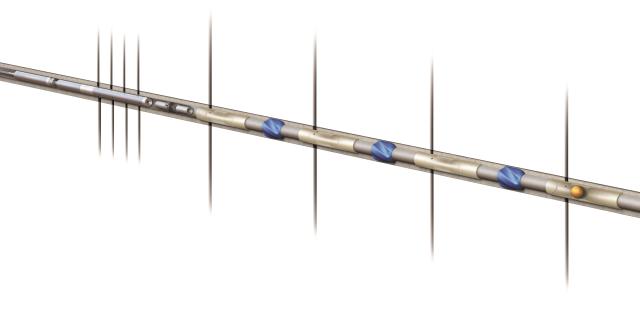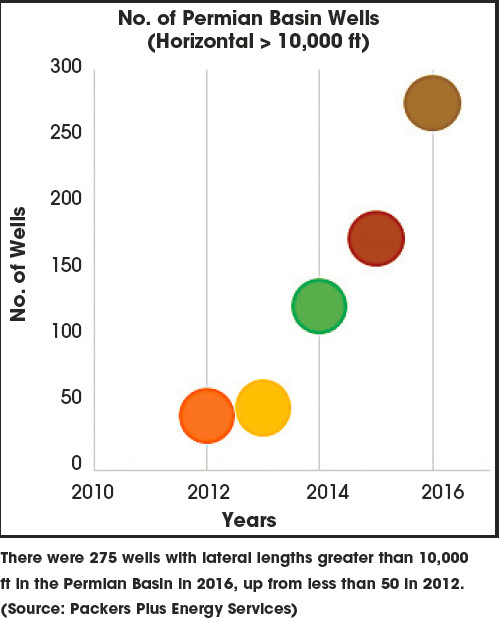
The Packers Plus QuickPORT IV sleeves of the same ball seat size allows multiple individually isolated stages to be grouped together in a single treatment zone. (Source: Packers Plus Energy Services)
Horizontal wells are lengthening at a near-exponential rate. For example, the number of wells in the Permian Basin with lateral lengths exceeding 3,048 m (10,000 ft) has increased over the past five years from fewer than 50 in 2012 to 275 in 2016.
Although longer laterals allow higher stage counts, it seems that one single completion technology has not been able to fill all parameters despite the variety of technologies available.
One particular challenge is the effective stimulation of the toe of the well. Operators have begun combining multiple completion technologies in a single well for a hybrid completion that aims to maximize the benefits of each technology and minimize the drawbacks.
 Drawbacks of existing technology
Drawbacks of existing technology
The plug-and-perf (PNP) methodology requires intervention to deploy tools, using wireline or coiled tubing (CT) for conveyance. In horizontal wells large volumes of water are needed to pump wireline perforating guns to depth, especially if there are doglegs and tight areas. CT provides an advantage with the ability to continually circulate fluid, which helps condition the well for smoother conveyance.
Conversely, a significant disadvantage of CT is its reach. Energized fluid, specialized metal-to-metal lubricants, and tractors or agitators can help with conveyance. However, when pushing tools to depth, CT tends to spiral due to cumulative friction. If CT is pushed too hard, it can kink or buckle, causing the tubing to become stuck or part.
CT generally should be treated with care because any damage from overpulling or fatigue leads to costly workarounds. Sometimes CT is made with thinner walls to gain a lighter or longer spool, and thinner tubing is even more easily damaged. For long wells these restrictions could leave the toe stages out of reach of CT.
CT also can be used to mechanically shift sliding sleeves inside the liner. The same benefits and limitations that apply to CT PNP also apply to CT sleeves.
Additionally, shifting of CT sleeves requires the maneuvering of downhole tools into small profiles without the benefit of seeing them. Two main events that are confirmed before each treatment are CT tool latch into the sleeve profile and sleeve opening.
When a sleeve slides open, it only moves several inches. This is not always perceptible when tools are 1,524 m to 3,048 m (5,000 ft to 10,000 ft) deep, and it often is difficult to determine if the sleeve moved partially or fully. Also, CT depth measurements are notoriously inaccurate, and CT has relatively low push strength at the toe of extended-reach laterals. These factors could, and have, resulted in the loss of stages.
Ball-activated sliding sleeves reduce or eliminate the need for intervention, which is a major benefit when completing the lower stages of long wells. Completions using these systems are executed using a continuous pumping operation and use a progressively larger ball to open a sleeve for each stage. Not only are ball-activated completions done in a fraction of the time required for PNP or CT-activated sliding sleeves, but they also use significantly less fluid.
When using the smallest balls to maximize stage count, the inner diameter (ID) of a liner can narrow down to 1 in. at the toe. For operations where maximum pumping rate is a priority or future intervention is a possibility, a larger ID at the toe might be desired. Since the biggest ball size is limited to the size of the liner, a larger ball at the toe limits the total number of stages possible.
For a high-density system, tighter ball and seat increments than standard 1⁄16 in. are deployed to increase stage counts. The design of these high-density ball seats includes hardened materials to mitigate the possibility of erosion from increasingly higher proppant tonnage and pump rates. This has been successfully proven with several wells completed in the Bakken Formation of more than 50 stages using the Packers Plus StackFRAC HD-X ball-activated system.
Hybrid technology completions
Each completion method’s limitations can be resolved or minimized by combining technologies for a hybrid completion. Hybrid completions have become particularly useful for extended-reach lateral wells.
For the toe of extended-reach laterals, hydraulic toe sleeves often are favored regardless of the completion method for the rest of the well. These sleeves are opened hydraulically without the need for intervention and initiate fluid flow into the reservoir to initiate stimulation. To lower operational risk and meet regulatory requirements, Packers Plus offers a line of testable toe sleeves that allow the liner to be pressured up once or multiple times before stimulation operations begin.
Ball-activated completions often are chosen for lower stages since they do not require conveyance by CT or wireline. Ball-activated sleeves in the toe of extendedreach laterals help to start the treatment process much faster and more efficiently than traditional PNP methods.
PNP or CT sleeves are typical for systems at the point where ball-activated seats reach the maximum size or when measured depths for upper stages are within easy reach.
Case studies
An operator working in the Meramec Formation in Oklahoma required an effective treatment method for proppant fracturing at the toe of a cemented PNP well with a lateral length of 1,408 m (4,620 ft).
Three ball-activated stages, each with five Packers Plus QuickPORT IV sleeves, were installed at the toe. Stimulation was achieved through each of the sleeves at the designed rate followed by 20 PNP stages. The transition time between consecutive ball-activated stages was only about 15 minutes.
An operator working in Alberta’s Montney Formation ran a 50-stage cemented hybrid system with a lateral length of 2,806 m (9,537 ft). The first 11 stages at the toe were completed using 10 ball-activated Packers Plus Diffusor sleeves and one hydraulically activated toe sleeve. The remaining stages at the heel were completed using CT activated sleeves.

Given the high formation breakdown pressures seen at the toe, a single-point entry system proved to be effective in ensuring that the desired stimulation treatment was achieved. Pumping fluid directly through the liner vs. using CT also enabled higher pump rates.
Hybrid completions using multiple technologies are an efficient method for effectively stimulating extendedreach laterals.
Wireline and CT have been steadily growing in length and capability. These intervention methods are often chosen for upper stages to lower costs or increase stage counts. However, the operational risks and completion times associated with completing the lower stages of an extended-reach lateral can be prohibitive. Hydraulic toe sleeves and ball-activated completions vastly reduce operational risks and completion times.
Recommended Reading
The Private Equity Puzzle: Rebuilding Portfolios After M&A Craze
2025-01-28 - In the Haynesville, Delaware and Utica, Post Oak Energy Capital is supporting companies determined to make a profitable footprint.
Hess Corp. Bucks E&P Trend, Grows Bakken Production by 7%
2025-01-29 - Hess Corp. “continues to make the most of its independent status,” delivering earnings driven by higher crude production and lower operating costs, an analyst said.
Phillips 66’s Brouhaha with Activist Investor Elliott Gets Testy
2025-03-05 - Mark E. Lashier, Phillips 66 chairman and CEO, said Elliott Investment Management’s proposals have devolved into a “series of attacks” after the firm proposed seven candidates for the company’s board of directors.
Exxon Slips After Flagging Weak 4Q Earnings on Refining Squeeze
2025-01-08 - Exxon Mobil shares fell nearly 2% in early trading on Jan. 8 after the top U.S. oil producer warned of a decline in refining profits in the fourth quarter and weak returns across its operations.
Phillips 66’s NGL Focus, Midstream Acquisitions Pay Off in 2024
2025-02-04 - Phillips 66 reported record volumes for 2024 as it advances a wellhead-to-market strategy within its midstream business.
Comments
Add new comment
This conversation is moderated according to Hart Energy community rules. Please read the rules before joining the discussion. If you’re experiencing any technical problems, please contact our customer care team.




